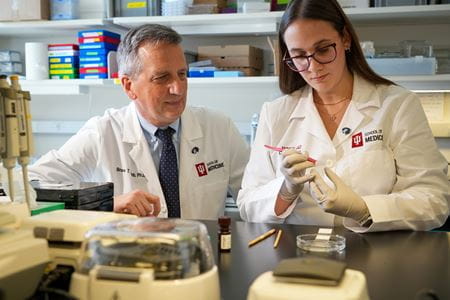A national resource for Alzheimer’s disease animal models and preclinical testing of therapeutics, led in part by Indiana University School of Medicine researchers, is the focus of a special issue of Alzheimer’s & Dementia, the journal of the Alzheimer’s Association.
Model Organism Development and Evaluation for Late-Onset Alzheimer’s Disease (MODEL-AD) researchers are developing new animal models of late-onset Alzheimer’s disease and performing rigorous testing of potential Alzheimer’s disease therapeutics.
“The special issue reflects the broad set of studies being done within MODEL-AD that are relevant to Alzheimer’s disease researchers,” said Bruce Lamb, PhD, executive director of Stark Neurosciences Research Institute and a principal investigator on the grant program. “MODEL-AD has been funded for eight years and thus is a very mature program with large amounts of new models, data and pre-clinical testing.”
MODEL-AD brings together experts at IU School of Medicine, Jackson Laboratory, the University of Pittsburgh School of Medicine and Sage Bionetworks. A second MODEL-AD center is based at the University of California Irvine. Since 2016, the IU School of Medicine-led center has received nearly $85 million in funding from the NIA, part of the National Institutes of Health.
Close to 55 million people worldwide—including nearly 7 million in the United States—are estimated to have Alzheimer’s disease or related dementias, according to the World Health Organization. In the U.S., that’s expected to rise to about 13 million people by 2050.
Past animal models for the disease have provided important insights in aspects of Alzheimer’s disease biology, but they have not sufficiently modeled the disease for accurate use in preclinical studies or translated into successful clinical trials.
Since MODEL-AD was first established, researchers have created more than 40 animal models carrying genetic risk variants that closely mimic human Alzheimer’s disease. These models have been characterized using molecular and imaging modalities used in the clinic, revealing Alzheimer’s disease relevant phenotypes not observed in prior mouse models.
“We have observed that animal models and data from these models are being widely used by the Alzheimer’s disease research community, with hundreds of animals being accessed through the Jackson Laboratory and data being accessed through the AD Knowledge Portal,” Lamb said. “Over 70 different published scientific papers have used MODEL-AD animals and data.”
This special issue contains descriptions of novel animal model generation, model characterization and preclinical testing data, Lamb said. This will assist investigators interested in understanding basic biological mechanisms underlying Alzheimer’s disease and analyzing data from animal models and preclinical testing of novel therapeutics for Alzheimer’s.
MODEL-AD consists of multiple cores across four institutions. The Bioinformatics and Data Management Core (BDMC) is led by Gregory Carter, PhD at the Jackson Laboratory; the Preclinical Testing Core (PTC) is directed by Paul Territo, PhD at IU School of Medicine and Stacey Rizzo, PhD at the University of Pittsburgh School of Medicine; and the Disease Modeling Project (DMP) is directed by Gareth Howell, PhD and Michael Sasner, PhD at the Jackson Laboratory and Lamb and Adrian Oblak, PhD at IU School of Medicine.
All animal models, protocols and validation data studied by MODEL-AD are shared online to the greater research community through the AD Knowledge Portal, run by Sage Bionetworks.
